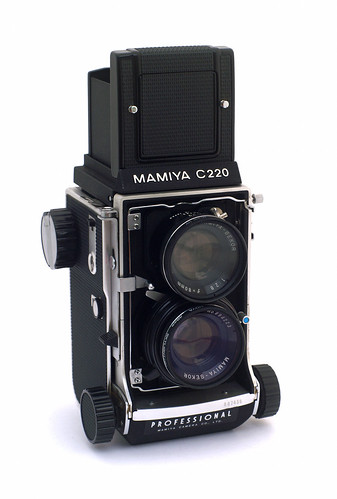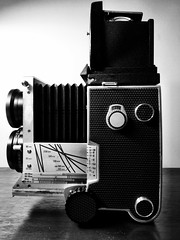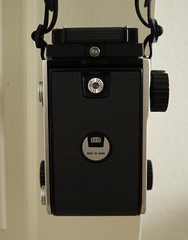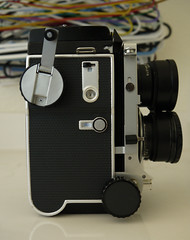Difference between revisions of "Mamiya C220"
(availaility) |
Hanskerensky (talk | contribs) (Added Category:C) |
||
| (7 intermediate revisions by 3 users not shown) | |||
| Line 1: | Line 1: | ||
| − | |||
{{Flickr_image | {{Flickr_image | ||
|image_source= http://www.flickr.com/photos/captkodak/271891486/in/pool-camerawiki | |image_source= http://www.flickr.com/photos/captkodak/271891486/in/pool-camerawiki | ||
| Line 9: | Line 8: | ||
}} | }} | ||
| − | The '''Mamiya C220''' was released in 1968 as part of the [[Mamiya C]] series of interchangeable lens [[medium format]] [[TLR]] cameras. It is an improved version of the [[Mamiya C22]]. The C220 was available for a very long time, in the early 1980's it was available from many dealers for | + | The '''Mamiya C220''' was released in 1968 as part of the [[Mamiya C]] series of interchangeable lens [[medium format]] [[TLR]] cameras. It is an improved version of the [[Mamiya C22]]. The C220 was available for a very long time, in the early 1980's it was available from many dealers for 60% less than the price of the [[Mamiya C330f]]. |
| − | Similar to other models in the series, it supports interchangeable finder viewing system allowing options such as a chimney style magnifier, eye level prism and the traditional waist level finder. The lens focus scales are on the left side of the bellows. It includes scales for 55mm, 65mm, 80mm, 105mm, 135mm, 180mm and 250mm lenses. The exposure [[parallax]] correction scale is below the focus scale. The [[shutter release]] has now changed to a plastic type trigger. Unlike the previous model there is no shutter release lock. | + | Similar to other models in the series, it supports interchangeable finder viewing system allowing options such as a chimney style magnifier, eye level prism and the traditional waist level finder. The lens focus scales are on the left side of the bellows. It includes scales for 55mm, 65mm, 80mm, 105mm, 135mm, 180mm and 250mm lenses. The exposure [[parallax]] correction scale is below the focus scale. The [[shutter release]] has now changed to a plastic type trigger. Unlike the previous model there is no shutter release lock. Similar to the previous model leatherette was not used for the body covering. Instead a proprietary Mamiya covering is used with a tiny raised letter 'M'. |
The back has been updated and no longer has the film loaded red window, as it fully supports both [[120 film|120]] and 220 film. It uses a rotating pressure plate inside the back. A new switch is above the frame counter dial to change between 120 or 220 film counters. A film format indicator window (controlled by the pressure plate) is also displayed on the back. Multiple exposure is fully supported with a dial on the right hand side of the body. The advance knob has been changed so that the knob now has a folding crank. | The back has been updated and no longer has the film loaded red window, as it fully supports both [[120 film|120]] and 220 film. It uses a rotating pressure plate inside the back. A new switch is above the frame counter dial to change between 120 or 220 film counters. A film format indicator window (controlled by the pressure plate) is also displayed on the back. Multiple exposure is fully supported with a dial on the right hand side of the body. The advance knob has been changed so that the knob now has a folding crank. | ||
| Line 20: | Line 19: | ||
|image_align= left | |image_align= left | ||
|image_text= bellows scales | |image_text= bellows scales | ||
| − | |image_by= Marcelo | + | |image_by= Marcelo Telles |
|image_rights= wp | |image_rights= wp | ||
}} | }} | ||
| Line 26: | Line 25: | ||
{{Flickr_image | {{Flickr_image | ||
|image_source= http://www.flickr.com/photos/37460295@N05/9044715901/in/pool-camerawiki/ | |image_source= http://www.flickr.com/photos/37460295@N05/9044715901/in/pool-camerawiki/ | ||
| − | |image= http://farm6.staticflickr.com/5496/ | + | |image= http://farm6.staticflickr.com/5496/9044715901_553656362b_m.jpg |
|image_align= left | |image_align= left | ||
|image_text= back | |image_text= back | ||
| Line 35: | Line 34: | ||
{{Flickr_image | {{Flickr_image | ||
|image_source= http://www.flickr.com/photos/37460295@N05/9045359176/in/pool-camerawiki/ | |image_source= http://www.flickr.com/photos/37460295@N05/9045359176/in/pool-camerawiki/ | ||
| − | |image= http://farm4.staticflickr.com/3780/ | + | |image= http://farm4.staticflickr.com/3780/9045359176_815ef036b7_m.jpg |
|image_align= left | |image_align= left | ||
|image_text= fold out crank knob | |image_text= fold out crank knob | ||
| Line 45: | Line 44: | ||
===Mamiya C220f=== | ===Mamiya C220f=== | ||
{{Flickr_image | {{Flickr_image | ||
| − | |image_source= | + | |image_source= https://www.flickr.com/photos/hojucandy/6838654463/in/pool-camerawiki/ |
| − | |image= | + | |image= https://live.staticflickr.com/7026/6838654463_a72bb5528c.jpg |
|image_align= right | |image_align= right | ||
|image_text= C220f | |image_text= C220f | ||
| Line 52: | Line 51: | ||
|image_rights= nc | |image_rights= nc | ||
}} | }} | ||
| − | A revised version was released in 1982 as the C220f. The film format counter setting is adjusted automatically with the rotation of the pressure plate in the back. It does not requires a separate switch to change between 120 and 220 settings. The back has added a film memo holder which sits on top of the film format window. The film back lock has changed. It requires a separate knob on the left hand side of the body. To operate, it requires pressing the knob while moving the | + | A revised version was released in 1982 as the C220f. The film format counter setting is adjusted automatically with the rotation of the pressure plate in the back. It does not requires a separate switch to change between 120 and 220 settings. The back has added a film memo holder which sits on top of the film format window. The film back lock has changed. It requires a separate knob on the left hand side of the body. To operate, it requires pressing the knob while moving the lever underneath downward. The film counter is reset to zero when the back opens. The multi exposure control dial is no longer a separate knob, it now surrounds the advanced knob. The advance knob no longer has the folding crank design, but has increased in size and moved downwards towards the centre of the body. The strap lugs are no longer a slot type. The included single action waist level finder no longer has a sport finder mode, but it is completely enclosed when using the magnifier. The body has returned to using a leatherette covering. |
| + | |||
| + | {{Flickr_image | ||
| + | |image_source= http://www.flickr.com/photos/vagn49/20733396429/in/pool-camerawiki/ | ||
| + | |image= http://farm6.staticflickr.com/5770/20733396429_5341548980.jpg | ||
| + | |image_align= left | ||
| + | |image_text= | ||
| + | |image_by= Vagn Sloth-Madsen | ||
| + | |image_rights= nc | ||
| + | }} | ||
{{br}} | {{br}} | ||
| Line 60: | Line 68: | ||
[[Category: Japanese 6x6 TLR]] | [[Category: Japanese 6x6 TLR]] | ||
| − | [[Category: Mamiya]] | + | [[Category: Mamiya|C220]] |
| + | [[Category:C|C220 Mamiya]] | ||
Latest revision as of 07:31, 18 February 2022

|
| C220 image by Steve Harwood (Image rights) |
The Mamiya C220 was released in 1968 as part of the Mamiya C series of interchangeable lens medium format TLR cameras. It is an improved version of the Mamiya C22. The C220 was available for a very long time, in the early 1980's it was available from many dealers for 60% less than the price of the Mamiya C330f.
Similar to other models in the series, it supports interchangeable finder viewing system allowing options such as a chimney style magnifier, eye level prism and the traditional waist level finder. The lens focus scales are on the left side of the bellows. It includes scales for 55mm, 65mm, 80mm, 105mm, 135mm, 180mm and 250mm lenses. The exposure parallax correction scale is below the focus scale. The shutter release has now changed to a plastic type trigger. Unlike the previous model there is no shutter release lock. Similar to the previous model leatherette was not used for the body covering. Instead a proprietary Mamiya covering is used with a tiny raised letter 'M'.
The back has been updated and no longer has the film loaded red window, as it fully supports both 120 and 220 film. It uses a rotating pressure plate inside the back. A new switch is above the frame counter dial to change between 120 or 220 film counters. A film format indicator window (controlled by the pressure plate) is also displayed on the back. Multiple exposure is fully supported with a dial on the right hand side of the body. The advance knob has been changed so that the knob now has a folding crank.

|
| bellows scales image by Marcelo Telles (Image rights) |

|
| back image by Studioesper (Image rights) |

|
| fold out crank knob image by Studioesper (Image rights) |
Mamiya C220f

|
| C220f image by Greg Williamson (Image rights) |
A revised version was released in 1982 as the C220f. The film format counter setting is adjusted automatically with the rotation of the pressure plate in the back. It does not requires a separate switch to change between 120 and 220 settings. The back has added a film memo holder which sits on top of the film format window. The film back lock has changed. It requires a separate knob on the left hand side of the body. To operate, it requires pressing the knob while moving the lever underneath downward. The film counter is reset to zero when the back opens. The multi exposure control dial is no longer a separate knob, it now surrounds the advanced knob. The advance knob no longer has the folding crank design, but has increased in size and moved downwards towards the centre of the body. The strap lugs are no longer a slot type. The included single action waist level finder no longer has a sport finder mode, but it is completely enclosed when using the magnifier. The body has returned to using a leatherette covering.

|
| image by Vagn Sloth-Madsen (Image rights) |